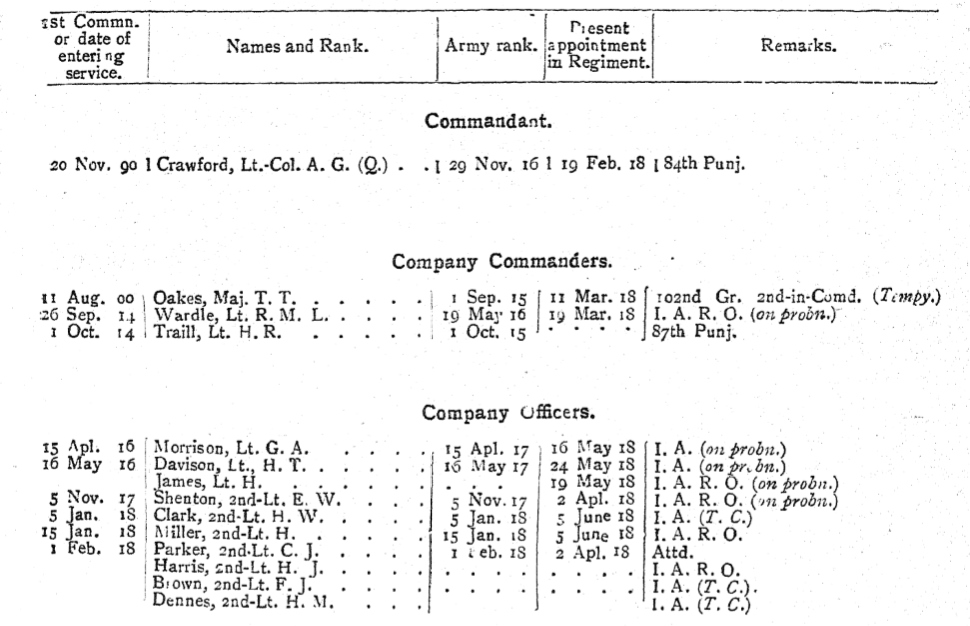This article on the 2nd Battalion 91st Punjabis aims to help you research this short-lived Indian infantry battalion and those who served with it during the First World War. I have written a separate article for the 1st Battalion 91st Punjabis and also a series of guides to help you research soldiers who served in the Indian Army during the First World War. The links below will take you to the guides:
The 2nd Battalion 91st Punjabis (Light Infantry) in the First World War
Lineage: The 2nd Battalion 91st Punjabis (Light Infantry) was formed at Ferozepore (Ferozepur, Punjab, India) on 26 February 1918 and disbanded on 1 June 1921. For a history of the Regiment’s lineage see my page on the 1st Battalion 91st Punjabis (Light Infantry).
Class Composition of Battalion in 1919: 8 Platoons of Hindustani Muslims, 4 Platoons of Punjabi Muslims, and 4 Platoons of Ahars.
The 2nd Battalion 91st Punjabis was a short-lived Indian infantry battalion formed at Ferozepore, now Ferozepur in India. The Battalion’s first commanding officer was Lieutenant-Colonel Arthur Gossett Crawford who was appointed from the 84th Punjabis on 19 February 1918. At some point during 1918, the Battalion left Ferozepore for Jubbulpore where its first confidential report was carried out by Brigadier-General Charles Gordon Prendergast C.B. who commanded Jubbulpore Brigade. His report, transcribed in full below, was dated 12 February 1919:
Drill: Fair.
Manoeuvre: Requires more attention and practice.
Musketry: Instruction is on sound lines and is satisfactory.
Fire Discipline: Satisfactory
Signalling: Is in an elementary stage and is making progress.
Bayonet Fighting: Satisfactory.
Physical Training: Is satisfactory and well taught.
Obstacle Course: Satisfactory.
Bombing: Satisfactory.
Lewis Gun: Satisfactory drill. Tactical handling requires more practice.
Marching Powers: Satisfactory.
Physical Appearance: Satisfactory.
Packing and Loading: Practised.
Discipline: Satisfactory.
Turnout: Requires more attention.
Personnel: Satisfactory with the exception that a senior 2nd-in-Command and more regular officers required.
Conduct: Satisfactory.
Health: Good.
Physique: Fair.
Recruits: Satisfactory except Ahirs whose military value is an uncertain quantity.
Interior Economy: Satisfactory.
General Efficiency: The battalion is young and inexperienced but is making progress.
I do not consider this battalion is yet fit for service; it is not yet a year old and though the officers are zealous and keen they are with the exception of the Commanding Officer young and inexperienced. The Commanding Officer has been much handicapped in consequence, his 2nd-in-Command being an Indian Army Reserve Officer of only 3 years’ service and he has found it difficult to cope with some 2,000 men mostly recruits.
The battalion is making fast progress and now with the numbers reduced by demobilisation should soon become efficient.
Confidential review reports on Indian Army units, depots, British officers, etc. for 1918-1919: IOR/L/MIL/7/17030.
The Battalion was still stationed at Jubbulpore in March 1920 but by June, had left for service in the Middle East, probably in Egypt. Its Depot was opened at Jubbulpore. While serving in the Middle East, at least one soldier of the Battalion died. The unfortunate man was Sepoy Qasim Ali from Kakrala who died on 29 September 1920. He is commemorated on the Heliopolis (Port Tewfik) Memorial in Cairo to those who have no known grave and died in either Egypt or Palestine. By February 1921, the Battalion had returned to Jubbulpore where it was disbanded on 1 June 1921. The extract below was taken from the July 1918 edition of the Indian Army List and shows the British officers serving with the Battalion. The number of British officers who were on probation (on. probn.) had a temporary commission (T.C.) or were from the Indian Army Reserve of Officers (I.A.R.O.) is typical of a war-raised Indian infantry battalion. There’s usually a wide variety of records to consult for these officers.
War Diaries for the 2nd Battalion 91st Punjabis (Light Infantry)
A war diary was written by a British officer of a unit and recorded its location and activities. Unfortunately, there are no war diaries for the 2nd Battalion 91st Punjabis.
Further Sources for the 2nd Battalion 91st Punjabis (Light Infantry)
For information regarding the British and Indian officers who served with the 2nd Battalion 91st Punjabis, the Indian Army List should be consulted. The confidential reports for the Battalion are held at the British Library: Confidential Reports on Regiments etc. IOR/L/MIL/7/17007-17037. These also contain the annual reports of the British officers who were serving with the Battalion at that time.

